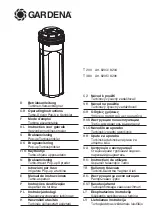
©Abundant Flow Water Systems, Inc. 2009
Revised 9/09
[1]
Pre-installation Preparation
IMPORTANT: Read through the entire instruction manual before beginning installation.
Abundant Flow Water is not responsible for any damage, injury, or monetary loss incurred from
failure to read and follow instructions.
Brief Technical Summary of the Filtration Process
Water enters the filter system and passes through a series of pre-filters. The sediment filter removes
particulates such as dirt and sediment. The GAC (granular activated carbon) removes a wide range of
chemicals (including chloramines), tastes, and odors. The carbon block filter removes chlorine and any
tastes and odors the GAC filter might miss. The pre-filters protect the membrane and should be
changed regularly to ensure maximum performance and membrane life. (NOTE: Some special order
systems may have different pre-filters). The water is then purified using a process called reverse
osmosis (RO). As the heart of the purification system, the RO process uses a semi-permeable, spiral-
wound membrane to separate and remove dissolved solids, organic, pyrogens, sub-micron colloidal
particles and bacteria from the water. Feed water is delivered under pressure at about 60 PSI through
the permeator where water permeates the minute pores of the membrane and is delivered as purified
water. Impurities in the water are concentrated in the reject stream and flushed to drain. The RO
Membrane is capable of removing 90% to 95% of contaminates present in the water. The
optional
UV
filter uses ultra violet light to destroy bacteria and viruses. The
optional
DI filter is composed of a mixed
bed of resin beads, some positively charged, some negatively charged. These charged resins
effectively strip the remaining impurities from the water, effectively removing 99%+ of contaminants!
The post filter gives a final polishing to ensure clean tasting water. The
optional
inline pH/mineral filter
ensures a neutral pH and adds beneficial minerals back into the water.
Water Purification Summary:
Stage 1:
Sediment Filer - Traps dirt, sediment, & particulates
Stage 2
: GAC (granular activated carbon) Filter - Chloramines, Tastes, Chemicals, & Odors
Stage 3:
Carbon Block Filter - Chlorine, Tastes, Chemicals, & Odors
Stage 4:
RO TFC Membrane - 90-95% of contaminates
Stage 5:
Optional
UV Filter - Kills bacteria, viruses, & cysts
Storage:
Pressurized Tank
Stage 6:
Optional
DI Filter - Removes 99% of any remaining contaminates
Stage 7:
Inline Post Filter - Polishing filter to ensure clean, fresh tasting water
Stage 8:
Optional
pH Filter - Neutralizes acidic water and adds calcium and magnesium
Delivery:
Standard RO Faucet
System Maintenance Summary:
Filters:
Filter maintenance will vary depending on water quality and water usage. For most homes with
average water quality and usage, every 6 months is usually sufficient. For higher water use and/or
dirtier water, more frequent filter changes may be needed. Filters need to be changed
at least
once a
year. If equipped, the UV bulb should be changed every 12 months. Use the chart in the important
information section for help determining the filter set needed for your system. Replacement filters can
be ordered online at
products.afwfilters.com
.
Membrane:
Average membrane life varies from 2-4 years depending on a number of factors. Reduced
water production or quality may indicate a fouled membrane, or a TDS meter can be used to monitor
the membrane. The membrane should be changed
at least
every 4 years.
Sanitization:
It is recommended that the system is sanitized once a year to prevent bacterial build up
and ensure a clean system. Even in homes with no known bacteria problem or bacteria prevention in
place it is a good idea to sanitize the system. If used in a home with a know bacteria problem, more
frequent sanitization may be a good idea.
Summary of Contents for ROFK5
Page 4: ...NOTES ...






































